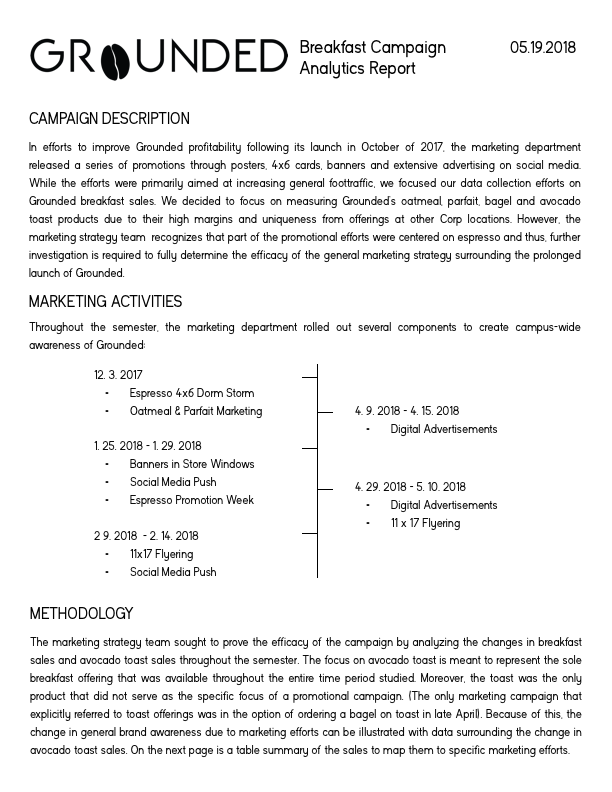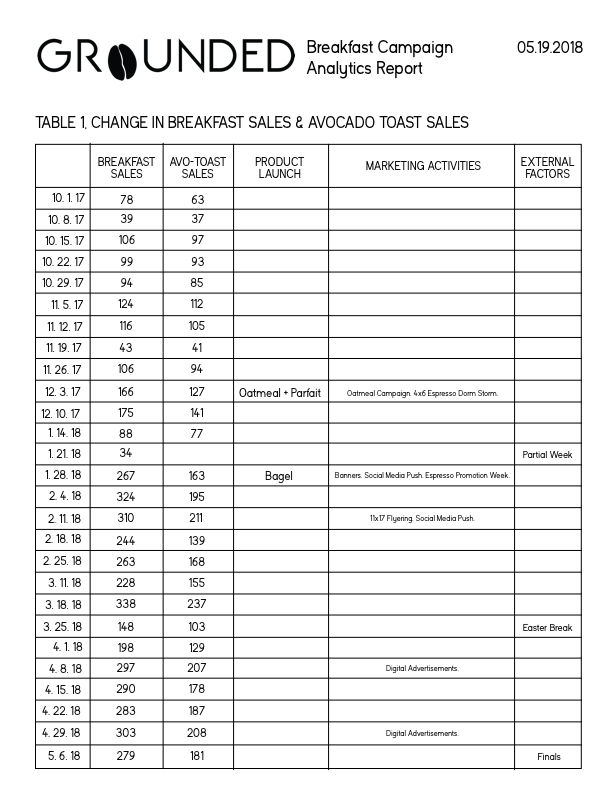STUDENTS OF GEORGETOWN INC.
INTRODUCTION
Students of Georgetown Inc. (commonly referred to as The Corp) is the largest student-run non-profit corporation in the world. With 410 employees, The Corp consists of 8 subsidiary companies, including four coffee storefronts, two convenient stores, a salad restaurant and a storage service. The company generates 5 million dollars in revenue annually and gives back $85,000 to the community in grants. I joined the company's marketing department in the fall of 2015 as a graphic designer and marketing strategist. For my first two years at the company, the marketing department functioned primarily as a graphic design and advertising branch of The Corp. However, over the past year, I have led the shift towards a data-driven department to introduce the role of analytics in the company's executive decision-making, inventory and marketing strategy. As Director of Data Analytics & Strategy, I have introduced a framework to shift the department's principal function from retroactive advertising to proactive, data-driven decision-making. I am the lead product manager of a team of data analysts and marketing strategists, who analyze sales and digital marketing data from Clover, Facebook and Google Analytical tools. This includes managing The Corp IT's data scientists responsible for coding sophisticated regressions for data analysts in the marketing department. I also product manage the website re-design and front-end wed development efforts. Scroll down to the bottom of the page to view examples of my reports analyzing ROMI of the Corp's marketing efforts.
THE PROBLEM
Previously, the largest problem facing the marketing department had consistently been the inability to determine the monetary return of marketing efforts and its focus on retroactive advertising rather than strategic marketing. The current structure relies on subsidiary service directors of marketing to submit requests which are assigned to a marketer to implement. This format had been used for years in The Corp and thus, translated into repetition of a similar trial and error: the service director of marketing arbitrarily ideated a campaign without any analytical information of product performance nor return on marketing investment (ROMI), and our department spent wage hours designing a poster campaign without proof that the medium is the most effective means to increase sales. In the last year, I have been part of the effort to analyze returns on marketing investment and the ways we can use data to better inform our Corp campaigns. In this effort, I led the dramatic restructuring to resolve two central questions that challenge the foundation of our current work: a) how do we determine which products should be marketed, and b) is our current focus on poster design the most effective use of wage hours.
SOLUTION: DEPARTMENTAL RESTRUCTURING
As the Director of Data Analytics & Strategy, I implemented a new structure that pushed forward the shift towards data driven marketing. Alongside the Director of Marketing, we worked to restructure the department into two categories: strategy team and implementation team. At the beginning of each semester, I manage the strategy team (comprised of ~5 members) to essentially lay out all marketing implementation tasks for the coming semester. After conducting meetings with each subsidiary storefront director and the Director of Marketing, in which the storefront director shares her vision, the strategy team turns those insights into actionable tasks.
This occurs in a series of reports which use analytics (specifically predicted ROMI) to propose campaigns, determine highest-returning campaign format (should this be an online campaign, paper, video or all three?), discount percentages for promotions and optimal time of rollout. These reports will primarily fall under 5 categories:
Service Requests (from Director of Services). These requests may include:
1) Director’s overall vision for the store and how to implement it
2) New product campaigns (ex. new Ice Cream at Vittles)
3) New store developments (ex. Grounded announcement
Re-occurring Large-scale Campaigns. These campaigns currently are:
1) Recruitment
2) Annual Storage Service
3) The Corp's Annual Fundraiser Gala
Scholarships: creating strategic partnerships to promote service scholarships
Re-occurring Product Campaigns:
1) Product campaigns annually rolled out (ex.Spring Drinks)
2) Data-backed product boosts based on insight from Accounting and IT Department
Corp Strategic Decisions:
Data collection on customer responses to potential Corp UM decisions (ex. user research on building new storefronts before deciding to do so).
PRODUCT MANAGEMENT ACROSS DEPARTMENTS
As Director of Strategy and Data Analytics, I serve as a direct liaison to the directors of the 8 subsidiary services to help guide strategist's efforts with the storefront vision, low-performing products (seen by weekly storefront spoilage data) and insights from each storefront's Director of Purchasing. I also work with the Accounting Department, so strategists can access inventory and sales data with monthly income-statements. Using this knowledge, I product manage a team of data scientists in The Corp's IT Department who build programs each week using Clover's API to query specific parameters requested by my marketing strategy team. With the IT created tool, the marketing strategist can analyze the predicted ROMI of a campaign, as well as draw larger analytical conclusions about directions for product inventory and The Corp's executive decisions. After this report is created, I create a series of tasks which then will be sorted by the General Manager to implementers in the video and design teams. Simultaneously, I work with the Director of Digital Marketing to oversee tasks for our digital marketers and social media managers.








